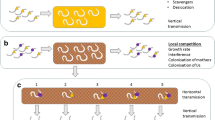Abstract
In the present study, we studied ecology of three species of mollusc-parasitic nematodes: Phasmarhabditis bohemica, P. bonaquaense and P. apuliae. We demonstrate that these facultative parasitic nematodes can grow in polyxenic and monoxenic combinations with bacteria Acinetobacter sp., Flavobacterium sp. and Pseudomonas sp. but some combinations do not support nematode reproduction. Bacteria Pseudomonas sp. did not support the growth of P. bonaquaense while P. apuliae grows only in combination with Flavobacterium sp. Composition of the culturing media apparently influenced the development time. Animal tissue-based substrates enabled slightly faster development than others. Similarly, also monoxenization of nematodes shortens the time to emergence of new dauer juveniles. Yields of dauer juveniles were usually higher in animal tissues than in other substrates. Generally, the most productive species was P. bohemica and the highest quality of dauer juveniles, expressed by their body size and lipid content, was reached in association with Flavobacterium sp. Our results provide the basis for further studies of monoxenic large scale production in liquid media and potentially development of these nematodes as promising mollusc biocontrol agents.



Similar content being viewed by others
References
Abu Hatab M, Gaugler R, Ehlers R-U (1998) Influence of culture method on Steinernema glaseri lipids. J Parasitol 84:215–221
Abu Hatab M, Gaugler R (1999) Lipids of in vivo and in vitro cultured Heterorhabditis bacteriophora. Biol Control 15:133–188
Ehlers R-U, Shapiro Ilan DI (2005) Mass production. In: Grewal PS, Ehlers R-U, Shapiro-Ilan DI (eds) Nematodes as biocontrol agents. CABI Publishing, Wallingford, pp 65–78
Friedman MJ (1990) Commercial production and development. In: Gaugler K, Kaya HK (eds) Entomopathogenic nematodes in biological control. CRC Press, Boca Raton, pp 153–172
Hooper DJ, Wilson MJ, Rowe JA, Glen DM (1999) Some observations on the morphology and protein profiles of the slug-parasitic nematodes Phasmarhabditis hermaphrodita and P. neopapillosa (Nematoda: Rhabditidae). Nematology 1:173–182
Lunau S, Stoessel S, Schmidtpeisker AJ, Ehlers R-U (1993) Establishment of monoxenic inocula for scaling-up in vitro cultures of the entomopathogenic nematodes Steinernema spp. and Heterorhabditis spp. Nematologica 39:385–399
MacMillan K, Haukeland S, Rae R, Young I, Crawford J, Hapca S, Wilson MJ (2009) Dispersal patterns and behaviour of the nematode Phasmarhabditis hermaphrodita in mineral soils and organic media. Soil Biol Biochem 41:1483–1490
Mengert H (1953) Nematoden und schnecken. Zeitschrif Für Morphologie Ökologie Tiere 48:311–349
Nermuť J, Půža V, Mráček Z (2014) The effect of different growing substrates on the development and quality of Phasmarhabditis hermaphrodita (Nematoda: Rhabditidae). Biocontrol Sci Technol 24:1026–1038
Nermuť J, Půža V, Mekete T, Mráček Z (2016a) Phasmarhabditis bonaquaense n. sp (Nematoda: Rhabditidae), a new slug-parasitic nematode from the Czech Republic. Zootaxa 4179:530–546
Nermuť J, Půža V, Mráček Z (2016b) Phasmarhabditis apuliae n. sp (Nematoda: Rhabditidae), a new rhabditid nematode from milacid slugs. Nematology 18:1095–1112
Nermuť J, Půža V, Mekete T, Mráček Z (2017) Phasmarhabditis bohemica n. sp (Nematoda: Rhabditidae), a slug-parasitic nematode from the Czech Republic. Nematology 19:93–107
Nguyen KB, Smart GC (1995) Morphometrics of infective juveniles of Steinernema sp. and Heterorhabditis bacteriophora (Nematoda: Rhabditida). J Nematol 27:206–212
Patel MN, Stolinski M, Wright DJ (1997) Neutral lipids and the assessment of infectivity in entomopathogenic nematodes: observations on four Steinernema species. Parasitology 114:489–496
Pieterse, A. (2020) In vitro production and biocontrol potential of nematodes associated with molluscs. Doctoral thesis, Faculty of agriscience, University of Stellenbosch, Stellenbosch
Rae RG, Robertson JF, Wilson MJ (2006) The chemotactic response of Phasmarhabditis hermaphrodita (Nematoda: Rhabditida) to cues of Deroceras reticulatum (Mollusca: Gastropoda). Nematology 8:197–200
Rae R, Verdun C, Grewal P, Robertson JF, Wilson MJ (2007) Biological control of terrestrial molluscs using Phasmarhabditis hermaphrodita - progress and prospects. Pest Manag Sci 63:1153–1164
Rae RG, Robertson JF, Wilson MJ (2009) Chemoattraction and host preference of the gastropod parasitic nematode Phasmarhabditis hermaphrodita. J Parasitol 95:517–526
Rae RG, Tourna M, Wilson MJ (2010) The slug parasitic nematode Phasmarhabditis hermaphrodita associates with complex and variable bacterial assemblages that do not affect its virulence. J Invertebr Pathol 104:222–226
Tan L, Grewal PS (2001) Infection behavior of the rhabditid nematode Phasmarhabditis hermaphrodita to the grey garden slug Deroceras reticulatum. J Parasitol 87:1349–1354
Wilson MJ, Glen DM, George SK, Pearce JD (1995a) Selection of a bacterium for the mass production of Phasmarhabditis hermaphrodita (Nematoda, Rhabditidae) as a biocontrol agent for slugs. Fundam Appl Nematol 18:419–425
Wilson MJ, Glen DM, Pearce JD, Rodgers PB (1995b) Monoxenic culture of the slug parasite Phasmarhabditis hermaphrodita (Nematoda, Rhabditidae) with different bacteria in liquid and solid phase. Fundam Appl Nematol 18:159–166
Wilson MJ (2012) Pathogens and parasites of terrestrial molluscs. In: Lacey LA (ed) Manual of techniques in invertebrate pathology. Academic Press, London, pp 427–439
Yang H, Jian H, Zhang S, Zhang G (1997) Quality of the entomopathogenic nematode Steinernema carpocapsae produced on different media. Biol Control 10:193–198
Acknowledgements
We give thanks to Biology Centre CAS, Institute of Entomology that provide fundamental support to our laboratory that enabled to realize this study (RVO: 60077344).
Funding
This study was supported by the Biology Centre CAS, Institute of Entomology (RVO: 60077344).
Author information
Authors and Affiliations
Contributions
JN wrote the manuscript, designed and conducted experiments and participated on statistical evaluation. MH participated on experiments and statistical evaluation. VP conducted statistical analyses, and revised the manuscript. All authors read and approved the manuscript.
Corresponding author
Ethics declarations
Conflict of interest
All authors declare that they have no conflicts of interests.
Ethical approval
This article does not contain any studies with human participants or animals performed by any of the authors.
Additional information
Handling Editor: Ralf Ehlers
Rights and permissions
About this article
Cite this article
Nermuť, J., Holley, M. & Půža, V. Growth and reproduction of monoxenic and polyxenic cultures of the slug-parasitic nematodes Phasmarhabditis spp. in naturally occurring organic substrates. BioControl 67, 533–542 (2022). https://doi.org/10.1007/s10526-022-10152-8
Received:
Accepted:
Published:
Issue Date:
DOI: https://doi.org/10.1007/s10526-022-10152-8




